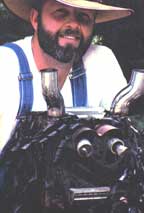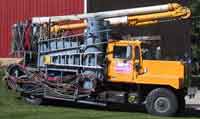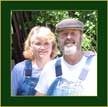![]() About Richard Arfsten
About Richard Arfsten
WHY I AM AN ARTIST
 Grandma always said, "Richard, you have ants in your pants.” I fidgeted and couldn't sit still — I always had to be busy and hated to get bored. Seventy-some years later I’m still that way. Even though I've retired from painting barns, I still have to keep busy — making art and dreaming up my next project. No one will ever accuse me of being a “couch potato” — I don’t even own a couch!
Grandma always said, "Richard, you have ants in your pants.” I fidgeted and couldn't sit still — I always had to be busy and hated to get bored. Seventy-some years later I’m still that way. Even though I've retired from painting barns, I still have to keep busy — making art and dreaming up my next project. No one will ever accuse me of being a “couch potato” — I don’t even own a couch!
Over 50 years ago I went into the barn-painting business with an old, broken down, $25 milk delivery truck, a couple of ladders, some brushes and rollers. I kept the paint (10 gallons) in Grandma’s big copper wash kettle that I pulled around in the kids’ red wagon. It sounds funny but it was slick and efficient. It sure beat carrying a five gallon pail, but there had to be a better way.
Being a bit of an inventor, it was easy to modify the truck and design a scaffolding system that mounted to it. That gave me an advantage over competitors who worked off of ladders. Next came an investment in airless spraying equipment, which was a new technology at the time. After that came an old aerial lift that I used as the heart of many trucks to come.
 During the off-season I cut up the existing set-up to reconfigure and improve the truck and experimented with other time-saving procedures like sand- and water-blasting. Over the years it has evolved into the super duper whooper painting truck I use today.
During the off-season I cut up the existing set-up to reconfigure and improve the truck and experimented with other time-saving procedures like sand- and water-blasting. Over the years it has evolved into the super duper whooper painting truck I use today.
When I first went into business it took me two weeks to clean and paint a barn. At the end of my career I could do it in a day or two — with no assistants! My work was super neat and lasted longer than other painters. I told potential customers, “If you hire me, you get Michelangelo. If you hire the other guy, you get his helpers.” I try to approach art the same way. I enjoy manipulating the process as much as doing the creative stuff.
In real life, like most artists, it was important to keep the day job. But after more than 50 years, due to health reasons, I had to retire from painting barns in Southeastern Wisconsin. While this was extremely hard work, it was also very satisfying. When I finished painting a barn it not only had received a stunning facelift, but it's life was extended as well. Unfortunately, in our fast-paced world, too many dairy farmers are forced to sell off their herds leaving the barn unused, neglected and eventually it falls into ruin. As a former member of the Wisconsin Barn Preservation Program, I tried to do whatever I could to save a barn from demise.
During an economic downturn I found myself essentially bankrupt. After a few months of being underfoot at home, my wife enrolled me in a sculpture class and said, “Richard, go chase your dream.” That was the beginning of my formal art training — and ironically the beginning of the end of my marriage.
Over the years I have studied various forms of sculpture, painting and printmaking at a number of schools throughout the United States and abroad. Such schools have included the Lyme Academy of Fine Art, Old Lyme Connecticut; Penland School of Craft and Art, Penland, North Carolina; Haystack School of Craft and Art, Deer Isle, Maine; Melbourne School of Art and Photography, Melbourne, Australia; Fleisher Art School, Philadelphia, Pennsylvania; and Johnson Atelier and Foundry, Mercerville, New Jersey (art metal casting apprenticeship). In 1992-1993 I was the visiting artist in residence at the Art Foundry of the Gulf Coast, Port Arthur, Texas. Before the program ended, I also studied foundry art at the Milwaukee Area Technical College for more than 20 years.
Various galleries in Wisconsin, Alabama, New Jersey and Maine have shown my work. Commissioned pieces are at the University of Minnesota at Crookston; Beloit College, Beloit, Wisconsin; Milwaukee County Zoo, Milwaukee, Wisconsin; Wisconsin Department of Justice, Madison, Wisconsin; University Hospital and Clinics, Madison, Wisconsin; and other private installations.
 My sculptural work represents a variety of styles and subjects with forms ranging from traditional bronze figures to large abstract pieces. I have won awards in figure modeling at the Johnston International Figure Sculpting competitions.
My sculptural work represents a variety of styles and subjects with forms ranging from traditional bronze figures to large abstract pieces. I have won awards in figure modeling at the Johnston International Figure Sculpting competitions.
Bronze, aluminum, steel, stainless steel, pewter and cast iron are metals I work in. My studio has metal welding and fabricating equipment allowing me to construct much of my work without using outside facilities.
Most of my cast designs are produced in various outside art foundries. Being a founder and an inventor, the process is as exciting to me as the modeling. By manipulating the processes I am able to develop new ways for casting metal that result in unusual surfaces and forms. For instance, it took five years of experimenting to refine the method and machinery I use for my evaporative pattern casting technique.
 My 2-D work , flat art (painting and printmaking), also represents many styles and subjects ranging from abstract to figurative. Most of the pieces are bold, powerful and full of color. Media used are oil-on-canvas, ink-on-paper and multi-media collage. I have my own printmaking studio, which enables me to print originals and editions, whether they be lithographs, serigraphs, etchings, collographs, etc.
My 2-D work , flat art (painting and printmaking), also represents many styles and subjects ranging from abstract to figurative. Most of the pieces are bold, powerful and full of color. Media used are oil-on-canvas, ink-on-paper and multi-media collage. I have my own printmaking studio, which enables me to print originals and editions, whether they be lithographs, serigraphs, etchings, collographs, etc.
HOW TO BUILD A PRINTMAKING STUDIO
For several years I was a student of Paul Yank (sculptor and printmaker). He taught me the process of making monotypes and monoprints using an etching press. Then Paul acquired a very old, offset, flatbed proof press, which changed my life forever.
In the printing industry, a preliminary sample (proof) of a job must be prepared and approved before the job can go on a high-production press. The old proof presses were used to produce the costly, super high-quality working color proofs. Technology has evolved and now these proofs are computer-generated and printed, making the proofing process faster and cheaper. The old proof presses are no longer needed and almost all of them have been scrapped.
When I saw Paul’s press it was love at first sight — envisioning a different use for it — not as a proof press, but as a super duper monoprinting machine. I tried to buy it from Paul, but the more we worked on it, the more he saw the value of it as well, and wouldn’t sell it to me. I decided I wanted one of my own. It was time to have some fun on a grander scale.
Thus began the quest for a proof press. After posting an ad on the Internet the ball started rolling. An old Vandercook 325 letterpress became available in Iowa. Adapting it for monoprinting seemed a new use for it. Soon we were on the road to Iowa in my old flatbed truck (the one with a small crane on it).
It was a weekday and the local merchants were occupying all of the parking spaces on the side street in front of the print shop where the press was located. I double-parked the truck and went in search of the cars owners. After several phone calls, we still couldn’t locate the owner of one particular car, which was parked right in front of the door the press was coming out of. Being a problem-solver, I decided to pick up the press with the crane and was going to swing it over the car and set it onto my truck. Midway in the process, the owner of the car came around the corner of the building. His eyes got really big when he saw 3,000 pounds of printing press dangling over his car as he shouted, “Please, please stop! I‘ll move the car!” Knowing that he owned an insurance business, I jokingly asked him, “you do understand risk, right?” He did — and promptly moved the car.
 Still really, really, wanting a proof press (which were extremely hard to find), I kept my ad on the Internet. That brought an email from a man in England and as they say, "the rest was history". We booked a flight to London and bought a F.A.G. 104, from master printer, John Moore (aka Prince John).
Still really, really, wanting a proof press (which were extremely hard to find), I kept my ad on the Internet. That brought an email from a man in England and as they say, "the rest was history". We booked a flight to London and bought a F.A.G. 104, from master printer, John Moore (aka Prince John).
He was retiring from the printing business but agreed to teach us (my Chickee and me), how to use it — the way it was intended to be used. John was a great teacher, a stern task-master, our daily biscuit (cookie) provider and remains a good friend. By the end of our stay in January, 2004, we had produced my first lithographic editions, and established our own publishing company called Two Trolls Publishing. (If you’re an artist and would like a press of your own, I know where you can get one!)
The trick of buying a press from out of the country is getting it home — you just don’t put it on a truck and drive it back to the studio. First you have to contract with a shipping company. Then you have to find someone to load it into a cargo box, get it to the shipping dock, load it onto a container ship, sail 14 days across the Atlantic Ocean, travel up the St. Lawrence Seaway into Canada, get it on a train and deliver it to a U.S. Custom’s compound in Chicago. Then you have to wait until it is inspected and clears Customs. (The 9-11 tragedy has made importing things into the U.S. a lot more complicated.) Once you get clearance, you have to hire someone to put it on a truck, drive 100 miles and deliver it to the studio. Then you have two hours to unload it from the cargo box on the truck. It’s only 14 feet long, 6 feet wide, and weighs 10,000 pounds. And then you have to find somebody who understands German electrical connections and can wire it to the appropriate American transformer — if you can find one. Piece of cake!
I needed a screen drying rack for the prints I was going to make. eBay to the rescue. I won a nice rack, which was in upstate New York. Lo and behold, the seller had another rack and a nifty silk screen press for sale as well. Always wanting to do serigraphs, which is a fancy name for screen prints, I bought it. Road trip! 10 quarts of transmission fluid (in my old van), and two days on the road we got it home. The studio was getting kind of full.
 Meanwhile, Mark Patsfall, a master printer in Cincinnati, Ohio, saw my ad and emailed me some photos of “Big Blue”, a very, very old Wagner offset flatbed proof press. The F.A.G. 104 is like a Mazeratti — the Wagner is like a Model T. We went to see it and I couldn’t pass it up — there are things I can do with this press that I can’t do with the F.A.G., like use the hand crank to go really, really slow, a great advantage at times.
Meanwhile, Mark Patsfall, a master printer in Cincinnati, Ohio, saw my ad and emailed me some photos of “Big Blue”, a very, very old Wagner offset flatbed proof press. The F.A.G. 104 is like a Mazeratti — the Wagner is like a Model T. We went to see it and I couldn’t pass it up — there are things I can do with this press that I can’t do with the F.A.G., like use the hand crank to go really, really slow, a great advantage at times.
After spending a small fortune getting the F.A.G. home, I decided to bring the Wagner back myself. I figured I had watched the others guys do it in England and with my background and equipment I could do it, no problem. Mark gave me a five-hour window to remove and load the press. After much engineering and moving it inch-by-inch, we got it to the loading dock door — only to discover it was an inch-and-a-half wider than the door. We had to take it apart to get it out. A day-and-a-half, and one broken thumb (sorry Mark) later, we had the press on the truck. We looked a lot like the Beverly Hillbillies going down the road, but we made it home without a hitch.
Next up was the Boca Raton odyssey. I got a call from an auctioneer in Florida who had seen my old ad on the Internet. He said he had a couple of Mailanders coming up for auction, starting on eBay and finishing up at his auction house in Boca Raton. It was going to be “such a deal.”
Well, to cut to the quick, we hooked up a trailer to the old van and headed down to Florida. Just before we got to Jacksonville a wheel bearing went out on the trailer. Getting that fixed delayed us for several hours and then a couple of traffic accidents on the Interstate slowed us down even more. Ten minutes from the auction house the presses went on the block. The auctioneer called on my cell phone — I bid, and wound up with, sight-unseen — 3 Mailanders, a complete screen-printing operation, and 8 more drying racks. It turned out the presses had belonged to a man who was a fine-art printer and he had passed away. I wish I could have met him before he died as he was doing exactly what I wanted to do.
I couldn’t fit much of the equipment in the van and little trailer we had brought, so I made arrangements to return with a bigger truck and bigger trailer. It turned out all of the stuff still wouldn’t fit in my truck. Eventually I had to hire a 53-foot, air-suspended logistics rig to bring two Mailander's and the rest of the equipment home. The real challenge that time was loading two 14-foot long, 10,000 pound presses into an 8-foot wide box — without a crane — but I managed.
By that time there wasn’t any room left in the studio for this “good deal” so a second “studio” had to be rented. So now we have big-time overhead — which means paint more barns — and sell more art!
You might ask, “Richard, why do you need so many presses?” There are probably a million answers, but the real one is, “because I like toys.” And now I’ve got my eye on a really cool etching press.
If you like toys too, give me a call and maybe we can arrange for "Big Blue" to come and live at your studio!
|
2017
|